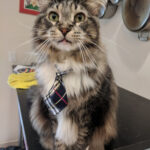- Litter box: This litter box is stainless steel and expensive but will last a very long time.
- Litter: Dr. Elsey’s Cat Ultra Premium Clumping Cat Litter (It clumps REALLY well and can be hard to scoop, but it smells fresh longer.)
- Litter Scoop: DuraScoop Jumbo Cat Litter Scoop. This is great for any plastic or metal litter box, but don’t use it on litter robots or it will tear the lining.
- Pet Carrier: Petmate Two Door Top Load Kennel
- Pet Fountain: All Stainless Steel Water Fountain (Some cats don’t drink enough water. Fountains make water more enticing.)
- Cat Trees: While certainly not a must-have, cat trees are great for working out that kitten energy! The ones below are recommended because they have pads that can be removed and washed:
- Scratching Post: Pioneer Pet SmartCat The Ultimate Scratching Post (It’s tall, so your cat can stretch out, and it’s very durable.)
- Turbo Scratcher: Bergan Turbo Scratcher Cat Toy (We’ve had the same one for 10 years, and our cats still love it.)
- Heartworm Medicine: Chewable tablets you can add to the cat’s food once a month (Be sure you purchase the appropriate type for the cat’s weight. You will need a vet to provide prescription approval.)
- Flea Medicine: Advantage II Kitten
- Quiet Toys: Petstages Night time Catnip Rolls (These don’t look like much, but kittens seem to love them, especially on hard flooring.)
- Spring Toys: Ethical Products Spot Colorful Springs Wide
- Interactive Toy: CatDancer
- Free/cheap household toys: shoelaces, hair ties, balls of foil, bottle caps, boxes
- Training Tools: PetSafe SSSCAT Spray (We use these around our Christmas tree and other places that are dangerous for cats. It’s motion activated and sprays compressed air in the direction of the cat, startling them and making them want to stay away from the area.)
- Cat harness/leash: Rella Cat Harness and Leash (It may seem silly, but having a leash can be helpful to keep tabs on your cat if you ever take them somewhere unfamiliar.)
- Fun books for cat-lovers: Cats on Catnip, Tiny Hats on Cats, Shop Cats of New York, Felines of New York
Feeding
As for feeding, a lot of times it ends up being up to a cat’s preference. I typically recommend starting with a half can of wet food (I use Friskies filets or pate for my resident cats) in the morning and half can in the evening, and leaving a small bowl of dry food out at all times. I use Hill’s Science Diet Indoor cat food, but you may want to start with kitten food if the kitten is under 1 year old. Kittens usually weigh about 1 pound per month of age (i.e. a 6-month-old should weigh about 6 pounds), capping out at about 10-12 pounds. If it seems like your pet is gaining weight too fast, you may want to take away the dry food.
